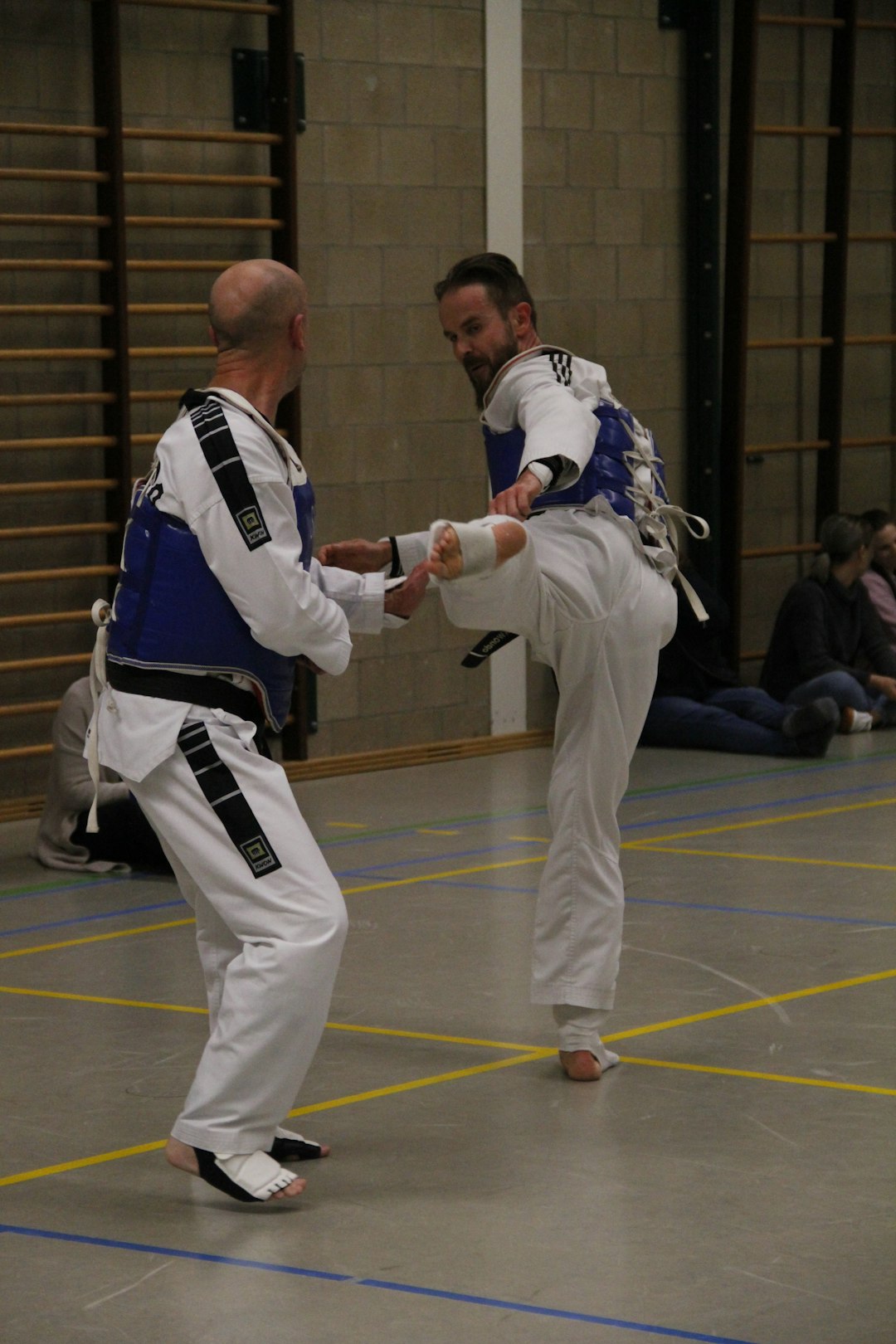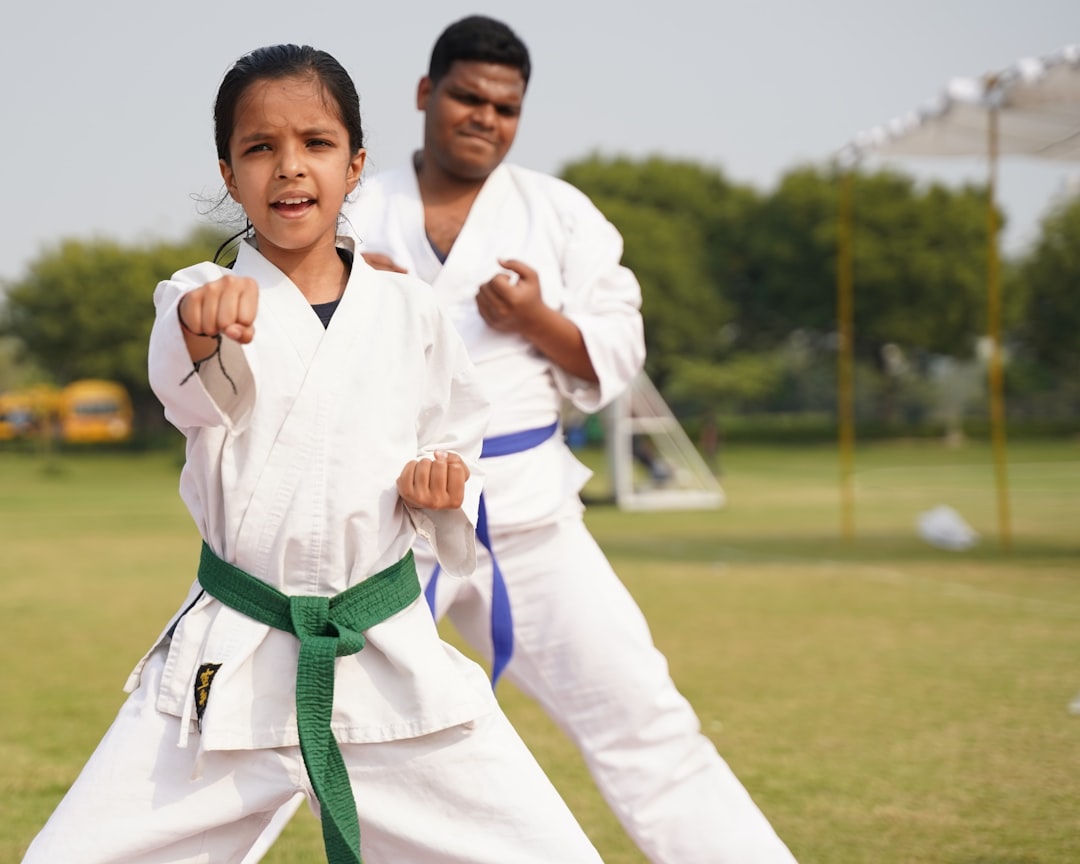When selecting karate equipment needed for effective practice and competition, it's crucial to choose a gi that strikes a balance between comfort, durability, and mobility. The ideal karate gi should be crafted from high-quality materials like heavy cotton or a durable fabric blend, allowing for full range of motion without being overly restrictive. It must also be breathable and resilient against the rigors of training. Proper sizing is key to ensure the gi supports your technique and remains comfortable throughout intense sessions. For beginners, a middle-ground fit between too tight and too loose is recommended. Additionally, protective gear such as gum shields, shin guards, hand protectors, groin guards, kick shields, focus pads, and punching bags are essential for safe sparring and impact training. Regular cleaning of your gi after each session using gentle detergent and following the manufacturer's instructions is vital to maintain its quality and functionality over time. By taking care of your karate uniform and other essential equipment, you ensure they continue to support your progress in the martial arts discipline.
When stepping into the world of martial arts, understanding the fundamentals of proper attire is key. A common query among beginners is “what do you call a karate suit?” This essential item, known as a Karate Gi, is more than mere clothing—it’s a symbol of respect and discipline within the practice. In this comprehensive guide on karate equipment needed, we’ll explore the significance of a Karate Gi, other vital components of training that go beyond the Gi to include protective pads and apparel, and offer insights on selecting and maintaining your Gi for both novices and experienced practitioners. Join us as we delve into the practical aspects of karate gear to ensure you’re fully equipped for your martial arts journey.
- Understanding the Essentials of Karate Gear: The Significance of a Karate Gi
- Key Components of Karate Training: Beyond the Gi to Protective Pads and Apparel
- Selecting the Perfect Karate Gi: Factors to Consider for Beginners and Seasoned Practitioners Alike
- Maintenance and Care for Your Karate Uniform: Ensuring Durability and Performance
Understanding the Essentials of Karate Gear: The Significance of a Karate Gi

When preparing for a karate practice or competition, selecting the appropriate gear is crucial. Among the essential karate equipment needed, the karate gi stands out as a pivotal piece. A karate gi is more than just a uniform; it’s a symbol of respect and tradition within the martial arts community. Typically composed of cotton or hemp, a karate gi is designed to facilitate movement while providing a standardized appearance for practitioners. Do the sleeves and pants offer the necessary range of motion without being overly restrictive? Is the fabric breathable and durable enough to withstand the rigors of training? Ensuring that the gi you choose meets these criteria will contribute significantly to your performance and comfort during practice. Are you considering the weight and weave of the fabric? The right gi can make a noticeable difference in both your training experience and your ability to execute techniques effectively. Additionally, the color of the gi often signifies the wearer’s rank within the dojo; white is typically reserved for higher belts, while beginners may start with a lighter colored or different style gi. What color gi will you be donning as you advance through the belt ranks? Making an informed decision on your karate gi will not only honor the tradition of the sport but also enhance your training experience.
Key Components of Karate Training: Beyond the Gi to Protective Pads and Apparel

When delving into the realm of karate, understanding the equipment needed is crucial for both beginners and seasoned practitioners. A karate gi, which is a traditional cotton uniform, is often the first piece of gear that comes to mind. However, beyond the gi, there are additional components of karate training that offer protection and enhance performance. For instance, protective pads, such as gum shields and shin guards, are essential for sparring sessions. These pads safeguard practitioners from potential injuries by absorbing impacts during practice strikes. Are hand protectors necessary in karate? Absolutely, hand protectors like mitts or gloves are vital for preventing damage to the hands and wrists during intense training or sparring matches. They provide a barrier against calluses and bruises that can occur from repetitive impact training. Similarly, groin guards are an important piece of equipment for male practitioners, offering essential protection during high-impact exercises. Furthermore, kick shields are indispensable in a dojo’s arsenal, designed to be worn by one practitioner while the other performs kicks, thus ensuring a safe environment for both individuals. The use of focus pads and punching bags also complements the training regimen, allowing karatekas to refine their striking techniques without risking injury to either participant in a drill. Incorporating these protective elements into your karate equipment arsenal is not just about safety; it’s about ensuring the longevity of your training and maximizing the effectiveness of your practice sessions. What does this comprehensive array of protective gear ensure? It guarantees that every karate practitioner can train with confidence, knowing they are well-equipped to handle the physical demands of their discipline.
Selecting the Perfect Karate Gi: Factors to Consider for Beginners and Seasoned Practitioners Alike

When selecting the perfect karate gi, also known as a karate uniform, for both beginners and seasoned practitioners, it’s crucial to consider several key factors. Firstly, the material of the gi should be durable yet comfortable. Karate equipment needed for optimal performance should be made from a heavy cotton or a blend that allows for ease of movement while withstanding the rigors of practice. Is the fabric breathable and resistant to wear and tear? The right gi will not only support your movements but also last through the strains of various techniques.
Another important aspect is the fit and sizing of the karate uniform. Karate equipment needed should not be too tight, restricting movement, nor too loose, causing the garment to catch on things or be a distraction. For beginners, it’s often recommended to opt for a gi that offers a middle ground between oversized and fitted. How does the gi feel when you execute various stances and movements? Does it constrain your range of motion? A well-fitted gi will move with your body, providing minimal distraction during practice or competition. Additionally, consider the weight of the gi; traditional karate gis are heavier, which can be more suitable for training as they mimic the feel of a heavy belt during kata and sparring. Remember, the best karate gi is one that complements your technique and enhances your practice without drawing unnecessary attention or causing discomfort.
Maintenance and Care for Your Karate Uniform: Ensuring Durability and Performance

When investing in karate equipment needed for consistent practice, the durability and performance of your karate uniform are paramount. To maintain the integrity of your gi, regular cleaning is essential to remove perspiration, dirt, and oils that can accelerate wear and tear. After each training session, it’s recommended to rinse your uniform in cold water to eliminate salt and odors. Does this initial rinse set the stage for a thorough cleaning process? Indeed, it does. Following the rinse, the gi should be washed using a gentle detergent and either a washing machine or hand-washing method, depending on the manufacturer’s instructions. Are there specific care instructions to follow for different materials of karate uniforms? Yes, synthetic fibers often require cooler water and a mild detergent to prevent shrinkage, while cotton gis may hold up better to slightly warmer temperatures and moderate detergents. Properly maintaining your karate uniform not only extends its lifespan but also ensures it performs as intended during practice, allowing you to execute techniques with optimal range of motion. Regular inspections for any signs of damage can also help in addressing issues promptly, such as replacing a belt if it becomes frayed or sewing on patches if the fabric starts to thin in high-use areas. By taking these steps, your karate uniform will remain a reliable partner in your martial arts journey.
When exploring the realm of karate, understanding the essential gear is paramount. Among the core equipment needed for any aspiring martial artist is the karate gi. This traditional uniform not only signifies respect for the discipline but also contributes to the practitioner’s performance and comfort during training. Beyond the gi, protective pads and apparel are crucial components of a well-equipped karate regimen, safeguarding both the student and their training partners. For those beginning their journey or veterans refining their practice, selecting the perfect karate gi requires careful consideration of material, fit, and durability. Proper maintenance and care ensure that this foundational piece of equipment remains in peak condition, optimizing its lifespan and performance. In essence, a comprehensive understanding of the necessary karate equipment needed lays the groundwork for a fulfilling martial arts experience, emphasizing the importance of well-selected and well-maintained gear in one’s training routine.
